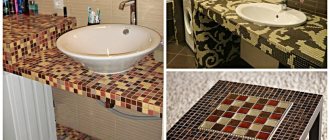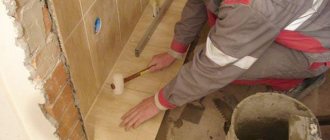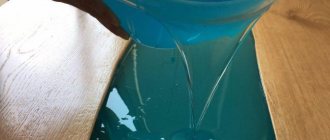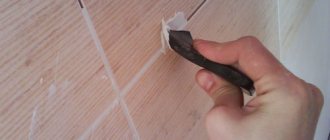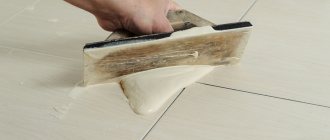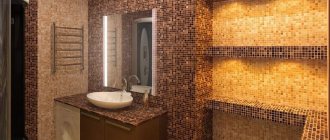To grout tile joints, in most cases a mixture based on cement is used. But it has a number of significant disadvantages, one of them is low moisture resistance and, as a consequence, the need for measures to increase resistance to moisture. That's why the creation of epoxy grout for tiles has solved many problems in interior decoration. True, experienced craftsmen have an ambiguous attitude towards the material, but each argues this in their own way.
Characteristics of epoxy grout
For many, when they hear about “epoxy,” they think of a well-known one-component composition used as an adhesive. However, a slightly different material, a special grouting paste, is used to grout tile joints. Its main components are: epoxy resin and a special hardener. Various fillers can also be added to enhance the decorative properties of the product.
What's good about this grout? Firstly, it is distinguished by maximum resistance to moisture. Water that falls on this surface is not absorbed at all, it simply rolls off. Moreover, the grout is not susceptible to all kinds of chemicals used in everyday life.
Scope of application of the composition
Epoxy grout is successfully used for both interior decoration and exterior work. It is indeed used for any cladding elements, not excluding even products with a glossy finish.
Grout based on epoxy resin can be used in the following cases:
- when you need to seal tile joints in the dining room, kitchen, hallway, bathroom or shower room;
- as a mixture for sealing the joints of tiles in a bathhouse, sauna or pool bowl;
- for reliable strengthening of tile joints on a terrace or open area;
- with joint widths ranging from 1 to 15 mm;
- technology allows you to apply this mixture even on a base equipped with a “warm floor” design.
Advice! If we take it more broadly, there are practically no restrictions in application. It is only necessary to make a small reservation that this grout paste is not entirely appropriate for lining stoves and fireplaces.
Manufacturers
Several of the most famous foreign and domestic manufacturers:
- Litokol (Italy). The material is stored for two years at a temperature of +5°C. The temperature must not be allowed to drop, otherwise the components will become hard and lose all their properties. This manufacturer offers grout in 103 colors, including various additional effects. Suitable for both indoor and outdoor use. The price ranges from the smallest (1 kg) - 1300 rubles, the medium (2.5 kg) - 3500 rubles. up to the largest package (5 kg) – 4000 rubles. Positive qualities of the brand's products:
- No smell.
- Suitable for use in rooms with poor air ventilation.
- Easy to apply.
- High resistance to temperature changes and high humidity.
- Mapei Kerapoxy. The main difference between the products of this manufacturer is that the grout has minimal grain size. However, the range of products is limited: only 26 colors are presented. The manufacturer produces a grout of three components, which is even more resistant to acids and other aggressive chemicals. Price 3 kg – 3500 rub., 10 kg – 5600 rub.
- "Diamant" (Russia). The grout is available in an assortment of 46 colors. But it can only be used to treat the bathroom. Sold in packages of 2.5 kg - from 2000 to 5000 rubles.
- "Basic." The epoxy grout from this company is characterized by high resistance to temperature changes (from – 50 to + 75°C), elasticity, hydrophobic properties and is not prone to the development of fungus. The solution is usable within an hour. The grout is available in 29 colors, packing 2.5 kg - 2000 rubles. In general, it has all the properties that are characteristic of epoxy.
- "Fugue". The product has all the properties characteristic of epoxy grout. Suitable for processing both indoors and outdoors. The solution is usable within two hours. The material is available in 32 colors. The cost varies significantly, for example, in online stores you can purchase 2.5 kg of dry mixture for literally 2,000 rubles, while in retail stores the product will be much more expensive.
Whatever company the buyer chooses, when starting to work, it is necessary to read the instructions on the packaging and act on them.
Pros and cons of using epoxy grout
Speaking about the wide scope of application of this composition, we can come to the conclusion that it has only advantages. Undoubtedly, there are many positive aspects associated with the use of epoxy grout:
- Durability. The duration of the operational period is measured in tens of years. Some manufacturers express confidence that their products will last more than 50 years.
- Increased strength. For simplicity, we briefly note that such a composition, when hardened, forms a very strong layer that is difficult to dismantle.
- Practically does not fade. The shades of the grout are able to maintain their brightness and saturation, even when exposed to direct sunlight for a long time.
- Not susceptible to deformation due to sudden temperature changes.
- Dries without shrinkage or cracking.
- Does not interact with aggressive chemicals. Of course, if etching is carried out intentionally, the material will gradually deteriorate.
- Does not contain elements harmful to human health. As a result, the solution can be used in any home.
However, one cannot fail to take into account the fact that in addition to the positive qualities of the composition, there are some disadvantages in its use:
- The resin hardens quite quickly, which limits the time of work and correction. Therefore, all actions must be performed clearly and correctly. Setting time is about 40 minutes.
- Only a special tool is suitable for the work, which you need to learn how to use.
- The price of epoxy mixture is higher than other types of material. Because of this, finishing large areas can have a significant impact on the overall cost of the renovation.
- If it is necessary to replace the grout, you will have to dismantle it along with the tiles. Naturally, there is a special chemical method, but it is very harmful and labor-intensive.
It follows from this that before choosing this composition, you need to weigh all its positive and negative sides.
Scope of use
Epoxy grout is widely used on various surfaces and under different operating conditions.
It is even used as glue on which mosaics are laid, but its most justified use is in the following places:
- kitchen;
- bath, shower, pool bottom, tank;
- heated floors;
- outdoor spaces;
- floor coverings with high traffic intensity.
The advantage of epoxy mortar for the kitchen is its resistance to staining: even difficult-to-remove stains such as wine, coffee or tea will not leave a trace on the seams after a simple wet cleaning.
Epoxy grout for bathroom tiles is used due to its moisture-proof properties. But not all of its characteristics are relevant there. Therefore, due to the high cost, the epoxy composition can be abandoned, and areas in contact with water can be treated with a sealant. However, if you want to get a reliable, high-quality and durable result, a reactive solution with epoxy resin is indispensable.
Another thing ? pool bowls and water tanks. With a large area and constant interaction with moisture, such areas need to treat the seams with an epoxy solution, which, moreover, will not become a breeding ground for bacteria and microorganisms.
External spaces and heated floors provide for temperature fluctuations, which epoxy grout is not afraid of. And its high abrasion resistance allows it to be used even in airports and metro stations.
How to choose grout color
Without exaggeration, epoxy grout can be called reliable protection. A very important issue remains the choice of its color. The content of pigment additives in the grout allows you to enjoy a rich color palette. Of course, from a wide variety you can choose the most suitable shade, but often this is not so easy.
Thanks to modern technologies, it has become possible to create almost completely transparent materials. If you want to add sophistication to the surface, there are special components that, with their shine, create the illusion of tiny stars.
To obtain a high-quality harmonious coating, basic recommendations were developed. Compliance with them will help to veil some of the imperfections of the room and draw attention to its advantages.
- Light-colored tiles are combined with pastel-colored grout to ensure surface unity and compositional integrity.
- To obtain the opposite effect, use dark tones. In this way, it will be possible to highlight individual details of the composition by dividing the surface into parts.
- When using plain tiles, the grout paste should be selected based on the main color scheme of the interior.
- The versatility of white is undeniable. It is appropriate to turn to it for sealing seams in any type of interior. It is not recommended to use it in corridors and hallways where traffic is high.
Of course, everyone can be guided by their imagination. In any case, the main goal is to get a room that brings joy to its owner.
Peculiarities
- Epoxy grout, unlike conventional cement grout, is completely waterproof, stable in color, resistant to stains and can withstand contact with most acids and alkalis.
- In addition, epoxy tile grout has a service life of more than 50 years without changes. Over time, the seams do not begin to darken.
- On average, the mixtures allow them to be used to fill joints from 1 to 15 mm when tiling ceramic, porcelain, glass, marble, metal, clinker, porcelain stoneware, agglomerate, natural stone and even wood.
- Epoxy grout is best suited for those premises where high demands are placed on the resistance of the coating to aggressive chemicals: swimming pools, garages and car washes, laboratories, workshops. It can also be used for surfaces that come into contact with food: aprons, countertops.
- Epoxy grout can also be used as a tile adhesive. This is especially true when laying mosaics made of glass and metal, so that the color of the seams and glue does not differ.
What mosaic looks like after grouting with epoxy mixture
But not everything is as rosy as we would like. There are also disadvantages:
- High price. In addition to the two-component grout itself, you need to buy a special solution to remove plaque. Imagine how much it will cost you to replace a defective element in a couple of years if you have to buy the same bucket to grout several joints.
- Difficulty at work. A technician without experience can easily ruin the entire result; if used incorrectly, the seams can turn out to be very rough and stains will remain on the surface of the tile. After application, the mixture cannot be leveled with a spatula, but only with a sponge, otherwise it will completely come out of the seam due to its elasticity.
- Rough surface. The epoxy grout itself has a surface similar to sandpaper - many people don’t like this. This is due to the coarse sand fraction, but in some species (for example, Mapei Kreapoxy) it is small and almost invisible. But this texture does not complicate the cleaning of seams from dirt.
Colors
Of course, color plays an important role and is one of the main parameters when choosing grout. It is provided by entering into the general composition immediately or by adding various pigments (dyes) during the mixing process, thanks to which the mixture can be black, white, or any other shade. This is also achieved by adding colored quartz sand and additional shiny components - glitters (for example, gold grout).
However, such diversity not only simplifies the design of the room, but also causes its own difficulties. If you can’t find the right shade, the manufacturer offers special dyes that are mixed with white grout.
There is also a completely transparent mixture that is perfect for working with stained glass windows.
Helpful tips when choosing grout color:
- Beige and pastel epoxy visually unites each tile into one seamless composition. But a dark-colored composition, on the contrary, is capable of visually dividing the wall into separate sections.
- For tiles that include three or more colors at once, or with complex patterns, the composition is selected according to the size of the workroom or surface itself. If the room is small, then the mixture should match the lightest tone, thus unifying the entire pattern. If the room is large, then the grout, on the contrary, corresponds to the darkest color.
- For single-color ceramic tiles, the mixture should be selected based on the colors that were used in the interior design. The grout should create a contrast with the topcoat, but not stand out from the background of the entire tile.
- If the facing tiles look like mosaics, then the mixture should be calm - beige or gray.
- If you can’t choose a suitable color, you can use standard white. However, if the tiles are flooring, then white grout cannot be applied, since over time it will lose its aesthetic appearance and will appear dirty gray.
- The original solution is to choose a mixture to match the furniture elements in the room, and not to match the tiles.
It is worth remembering that the bathroom should not use more than three different shades.
Advantages of epoxy grout
Note that polymer grout is much more expensive than conventional cement grout. The second drawback is the difficulty of cleaning the hardened composition from the front side of the tile or mosaic. Otherwise, grout has the same advantages:
- Seams filled with grout do not absorb dirt and dust. Cured “epoxy” resembles plastic in its properties. Even if dirt sticks to the surface of the seams, it will not be difficult to wash it off. You can use any household chemicals, even strong ones, or clean the seams with a wire brush. The main thing is not to damage the tile itself. This quality is of great importance when cleaning mosaics - the number of seams in this type of coating is an order of magnitude greater than in conventional tiles.
- Epoxy grout for tiles and mosaics does not change color when water or chemicals come into contact with its surface. This material, in principle, does not react in any way upon contact with them and does not absorb any compounds. For this reason, epoxy self-leveling floors, which are similar in formula to grout, are used in the construction of various laboratories and chemical industry enterprises.
- After hardening, epoxy grout does not change its technical characteristics throughout its service life. If you happen to dismantle tiles whose seams were sealed with epoxy grout, you will see that it is as strong as the ceramic itself, and sometimes even surpasses it.
If this is your first time working with this kind of grout, we recommend that you start working with seams in a small area. For example, experiment in the bathroom. The high viscosity of the material makes it difficult to apply grout into voids, but it is worth it.
Flaws
- high cost compared to others;
- short hardening period - you have to knead in small portions;
- Repairs can only be made by completely replacing the tiles;
- The job requires certain professional skills.
We can conclude that all the disadvantages are associated with the characteristics of this grout and its relatively high price. In all other indicators, it is far ahead of its competitors. The high cost is compensated by an unusually long service life without changing properties or appearance.
How to work with the solution correctly
Before starting activities with two-component grouting, it is necessary to prepare the tool. To carry out the work comfortably you will need:
- wide rubber spatula;
- spatula forming seams;
- a drill and a nozzle specially designed for mixing the solution;
- cellulose sponge for construction work, which retains its properties for a long time;
- grater with cellulose attachment;
- latex gloves;
- goggles to prevent mixture from getting into your eyes when working at heights.
Advice! A cellulose sponge can also be replaced by ordinary foam rubber, but you will need much more of it.
You will also probably need a scraper to remove dried compound from the tiles and a soft cloth.
Be sure to follow safety precautions! Although toxic substances are not released from the finished coating, contact of the liquid mixture with the mucous membrane of the mouth, eyes, as well as inhalation of its vapors is highly likely to provoke irritation and a more serious reaction.
Preparation of the solution
As we mentioned earlier, epoxy mosaic grout is sold in two parts, each in separate packages. The main component is epoxy resin, which includes additives in the form of quartz sand, dyes, and plasticizers. The second component, which plays a secondary role, is the hardener. You need to mix a small amount of product. Excess is not needed, as it will lead to the material losing its qualities. And this situation cannot be corrected.
So, you need to pour both components into one container and mix thoroughly. In order for the mixture to “reach”, it must be left for 5 minutes. After this, mix again.
Advice! Mixing should be done with a drill smoothly at low speeds. Otherwise, air bubbles will form and the seam will become porous when dry.
The order of filling the seams
Epoxy grout should be properly applied to slab joints as follows:
- Carry out thorough cleaning of the gaps from the slab adhesive. The result should be clean crevice spaces free of dirt and dust.
- Clear spaces from plastic crosses or tile leveling system elements.
- It is strictly forbidden to wet the surface. The base must be dry. Otherwise, applying mastic will be very difficult.
- Apply the mixture with a hard rubber-coated spatula. Distribute it evenly along the seams of the entire area.
- Form decorative joints on the treated area.
- To simplify the procedure, it is recommended to cover the edges of the tiles with masking tape.
Advice! During work, you must carefully monitor the appearance of excess and remove it immediately. If you leave pieces of the mixture for more than 5 minutes, you will need to force them off.
After all the seams have been uniformly filled in one area, the mixture must be wiped off with a sponge dipped in warm water. The resulting stains can be left and subsequently removed with a special product, which is purchased in addition to the composition.
The grout will finally harden in five days. The surface will acquire the desired qualities and resistance to various influences.
Choosing the appropriate composition
First of all, you need to pay attention to the type of main components that the epoxy-based grout contains. The composition of such materials may include cement, various additives that increase elasticity and improve other properties. The cost of grouting will depend on this. Another factor is brand. Common options:
- Mapei Kerapoxy Design;
- Litokol Litochrom Starlike;
- Diamond.
The cost varies between 900-1100 rubles. per 1 kg of substance. The grout does not have to be updated regularly, since it does not lose its properties throughout its entire service life.
By comparison, the cement version quickly deteriorates. This substance loses strength, over time it begins to absorb moisture more strongly, and cracks form on the surface.
You also need to calculate the volume of grout required to finish the wall or floor. In this case, information from the manufacturer is taken into account. In most cases, the label indicates how much substance is consumed per 1 m². Based on this, you need to calculate the total amount of grout per area to be treated. If you immediately purchase the required amount of material, you can reduce the surface finishing time.
Possible errors
It happens that inexperienced craftsmen, when preparing the grout mixture, do not comply with the proportions specified in the instructions. This leads to the loss of valuable qualities by the material.
Often, careless craftsmen, when working with epoxy composition, use the same tools as for cement grout. Of course, this saves money, but the result obtained does not justify the savings. Specific material requires the use of special fixtures and tools.
If the work is carried out correctly, in compliance with the technology, the result will cause only positive emotions and favorable consequences for both the master and the customer.
